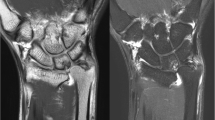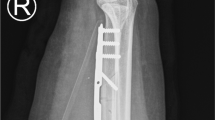Type of study/level of evidence Therapeutic IV
Abstract
Background
Although precise ulna-shortening osteotomy is popular, the procedure sometimes results in delayed union or nonunion. The periosteum including the inner cambium layer plays an important role in fracture healing. We tested the hypothesis that preservation of the corticoperiosteal attachment may accelerate healing at osteotomy sites after ulna-shortening osteotomy.
Methods
We performed a chart review of 32 patients who underwent ulna-shortening osteotomy for ulnar impaction syndrome or triangular fibrocartilage complex tears in a retrospective single-surgeon series. Of the 32 cases, the periosteum was preserved in 21 osteotomies performed from April 2009 onwards (periosteum-preserved group) and not preserved in 11 osteotomies performed before April 2009 (control group). Following sugar tong immobilization, patients in both groups used a short wrist supporter during the first two postoperative weeks (POW) and up to at least four POW. Union of the osteotomy site was assessed at 2-week intervals using radiographs taken at three different projections until 12 POW and at 4-week intervals thereafter until 24 POW. Ulna shortening was performed using a transverse osteotomy cut with the aid of a commercially available compression device.
Results
All osteotomies achieved complete union except in one case in the control group. The mean interval to complete cortical union was 7.7 weeks in the periosteum-preserved group and 9.5 weeks in the control group. The corresponding mean times for endosteal union were 15.6 and 21.8 weeks. The periosteum-preserved group had reduced times for both types of union but only the endosteal union time was significantly different from the control group.
Conclusions
Preservation of the corticoperiosteal attachment significantly shortened the endosteal union time. Our results indicate that preservation of the periosteum may accelerate bone healing after ulna-shortening osteotomy.


Similar content being viewed by others

References
Katz DI, Seiler 3rd JG, Bond TC. The treatment of ulnar impaction syndrome: a systematic review of the literature. J Surg Orthop Adv. 2010;19:218–22.
Tatebe M, Shinohara T, Okui N, et al. Clinical, radiographic, and arthroscopic outcomes after ulnar shortening osteotomy: a long-term follow-up study. J Hand Surg [Am]. 2012;37:2468–74.
Fufa DT, Carlson MG, Calfee RP, et al. Mid-term results following ulna shortening osteotomy. HSS J. 2014;10:13–7.
Chen F, Osterman AL, Mahony K. Smoking and bony union after ulna-shortening osteotomy. Am J Orthop (Belle Mead NJ). 2001;30:486–9.
Sunil TM, Wolff TW, Scheker LR, et al. A comparative study of ulnar-shortening osteotomy by the freehand technique versus the Rayhack technique. J Hand Surg [Am]. 2006;31:252–7.
Murao H, Yamamoto K, Matsuda S, et al. Periosteal cells are a major source of soft callus in bone fracture. J Bone Miner Metab. 2013;31:390–8.
Sakai K, Doi K, Kawai S. Free vascularized thin corticoperiosteal graft. Plast Reconstr Surg. 1991;87:290–8.
Doi K, Hattori Y. Vascularized bone graft from the supracondylar region of the femur. Microsurgery. 2009;29:379–84.
Del Piñal F, García-Bernal FJ, Regalado J, et al. Vascularised corticoperiosteal grafts from the medial femoral condyle for difficult non-unions of the upper limb. J Hand Surg (Br). 2007;32:135–42.
Rodríguez-Vegas JM, Delgado-Serrano PJ. Corticoperiosteal flap in the treatment of nonunions and small bone gaps: Technical details and expanding possibilities. J Plast Reconstr Aesthet Surg. 2011;64:515–27.
Hamada Y, Hibino N, Kobayashi A. Expanding the utility of modified vascularized femoral periosteal bone-flaps: an analysis of its form and a comparison with a conventional-bonegraft. J Clin Orthop Trauma. 2014;5:6–17.
Giebel GD, Meyer C, Koebke J, et al. Arterial supply of forearm bones and its importance for the operative treatment of fractures. Surg Radiol Anat. 1997;19:149–53.
Wright TW, Glowczewskie F. Vascular anatomy of the ulna. J Hand Surg [Am]. 1998;23:800–4.
Menck J, Schreiber HW, Hertz T, et al. Angioarchitecture of the ulna and radius and their practical relevance. Langenbecks Arch Chir. 1994;379:70–5.
Urita A, Iwasaki N, Kondo M, et al. Effect of low-intensity pulsed ultrasound on bone healing at osteotomy sites after forearm bone shortening. J Hand Surg [Am]. 2013;38(3):498–503.
Berggren A, Weiland AJ, Ostrup LT, et al. Microvascular free bone transfer with revascularization of the medullary and periosteal circulation or the periosteal circulation alone. A comparative experimental study. J Bone Joint Surg Am. 1982;64:73–87.
Vegas MR, Delgado P, Roger I, et al. Vascularized periosteal transfer from the medial femoral condyle: is it compulsory to include the cortical bone? J Trauma Acute Care Surg. 2012;72:1040–5.
Acknowledgments
No benefits in any form have been received or will be received from a commercial party related directly or indirectly to the subject of this article. No funds were received in support of this study.
Conflict of Interest
Yoshitaka Hamada declares that he has no conflict of interest.
Koichi Sairyo declares that he has no conflict of interest.
Naohito Hibino declares that he has no conflict of interest.
Ryosuke Sato declares that he has no conflict of interest.
Anna Kobayashi declares that he has no conflict of interest.
Statement of Human and Animal Rights
All procedures followed were in accordance with the ethical standards of the responsible committee on human experimentation 140 (institutional and national) and with the Helsinki Declaration of 1975, as revised in 2008
Statement of Informed Consent
Identifying information, including patients’ names, initials, or hospital numbers, was not published in written descriptions, photographs, and pedigrees.
Author information
Authors and Affiliations
Corresponding author
About this article
Cite this article
Hamada, Y., Sairyo, K., Hibino, N. et al. Effect of preservation of corticoperiosteal attachment on bone healing at osteotomy sites after ulna-shortening osteotomy. HAND 10, 105–110 (2015). https://doi.org/10.1007/s11552-014-9662-6
Published:
Issue Date:
DOI: https://doi.org/10.1007/s11552-014-9662-6



